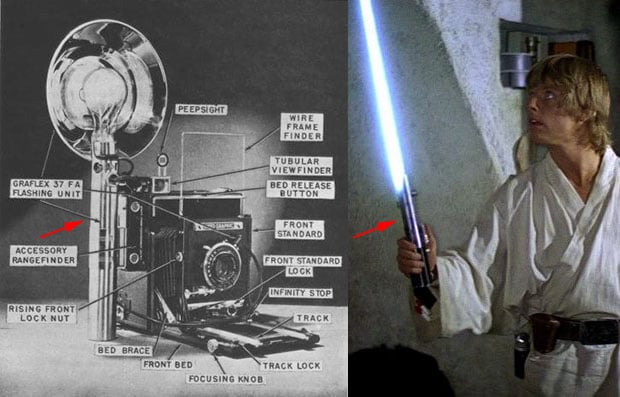What Are Lightsabers Made Of?
Lightsabers, those iconic weapons from a galaxy far, far away, have always captured the imagination of fans young and old. But have you ever wondered what these magnificent weapons are made of? Well, buckle up because we’re about to dive into the captivating world of lightsaber construction.
Lightsabers are not your average everyday weapons. They are elegant, sleek, and packed with advanced technology. So, what exactly are they made of? The core component of a lightsaber is a crystal, typically a Kyber crystal, which is known for its unique properties. These crystals are found in various colors and each color represents a different connection to the Force. The Kyber crystal is then placed inside a hilt, which acts as the handle of the lightsaber. The hilt is crafted using a combination of metals, alloys, and sometimes even rare materials like Mandalorian iron or Phrik. This ensures durability and strength, allowing Jedi and Sith alike to wield their lightsabers with precision and power.
In summary, lightsabers are a fusion of ancient mysticism and cutting-edge technology. The combination of a Kyber crystal and a meticulously crafted hilt creates the iconic weapon we all know and love. So, the next time you watch a Star Wars movie or engage in a lightsaber battle with your friends, remember the incredible craftsmanship and unique materials that make these weapons truly out of this world. May the Force be with you!

What are Lightsabers Made of?
Lightsabers, the iconic weapons of the Jedi and Sith in the Star Wars universe, have captivated audiences for decades. These elegant and powerful weapons are known for their distinctive glowing blades and ability to cut through almost anything. But have you ever wondered what lightsabers are actually made of? In this article, we’ll explore the materials that make up lightsabers and delve into the science behind these legendary weapons.
The Hilt
The hilt of a lightsaber is the handle that a Jedi or Sith uses to wield the weapon. It serves as both a grip and a housing for the internal components that create the blade. Lightsaber hilts are typically made from various materials, each with its own unique properties and aesthetics.
One common material used in lightsaber hilts is durasteel, a durable and lightweight alloy known for its resistance to corrosion. Durasteel is often favored by Jedi and Sith who value reliability and practicality in their weapons. Another material commonly used is phrik, a rare and incredibly strong metal that is resistant to lightsaber blades. Phrik hilts provide additional protection to the wielder and can withstand intense combat situations.
The Blade
The blade of a lightsaber is the most iconic and visually striking part of the weapon. It is created using a combination of advanced technology and the mystical power of the Force. The blade is made up of pure energy, emitted from a crystal housed within the hilt.
The crystal that powers a lightsaber is called a kyber crystal. Kyber crystals are Force-attuned crystals that resonate with the energy of the Force. They are typically colorless until they are bonded with a Jedi or Sith, at which point they take on a specific color. The color of a lightsaber’s blade can vary, with blue and green being commonly associated with Jedi, and red being associated with Sith.
The Power Source
To power the blade and other functions of the lightsaber, a power source is necessary. Lightsabers are typically powered by energy cells, which provide the necessary power for the weapon to function. These energy cells can be rechargeable or disposable, depending on the design and preference of the wielder.
In addition to energy cells, lightsabers also utilize power regulators and energy modulation circuits to ensure a stable and controlled output of energy. These components help prevent the lightsaber from overheating or malfunctioning during intense combat.
Additional Components
While the hilt, blade, and power source are the primary components of a lightsaber, there are other elements that contribute to the overall functionality and effectiveness of the weapon. These include the emitter, which focuses and shapes the energy into a blade, and the focusing crystal, which helps refine and control the blade’s properties.
Lightsabers may also include auxiliary features such as adjustable blade length, dual-phase blades, and even a built-in sound module to create the iconic humming sound when the weapon is ignited. These additional components add versatility and customization options for the wielder.
Overall, lightsabers are a combination of advanced technology and the mystical power of the Force. The materials that make up lightsabers, from the durable hilts to the energy-emitting kyber crystals, contribute to their unique and awe-inspiring nature. Whether in the hands of a Jedi or a Sith, lightsabers continue to captivate audiences and ignite the imagination.
Bulleted List:
– Durasteel and phrik are commonly used materials for lightsaber hilts.
– Kyber crystals are the source of a lightsaber’s blade color and power.
– Energy cells provide the necessary power for lightsabers to function.
– Power regulators and energy modulation circuits help maintain stability.
– Additional components like the emitter and focusing crystal enhance the lightsaber’s functionality.
– Lightsabers can have adjustable blade length, dual-phase blades, and sound modules.
Conclusion
In conclusion, lightsabers are made of a combination of materials such as durasteel and phrik for the hilt, kyber crystals for the blade, and energy cells for the power source. These components, along with additional features and auxiliary components, create the iconic and powerful weapons wielded by Jedi and Sith. Lightsabers continue to capture the imagination of fans and remain an enduring symbol of the Star Wars universe. So, the next time you watch a Star Wars film or engage in a lightsaber battle in a video game, you’ll have a deeper understanding of what makes these weapons so legendary.
Key Takeaways: What are lightsabers made of?
- Lightsabers are fictional weapons often seen in the Star Wars universe.
- They are made of a hilt, which is the handle, and a blade of pure energy.
- The hilt is typically made of metal and can be customized with various designs.
- The blade is created using a fictional crystal called a kyber crystal.
- When activated, the kyber crystal emits a plasma energy that forms the blade.
Frequently Asked Questions
What materials are lightsabers made of?
Lightsabers, the iconic weapons of the Jedi and Sith, are made up of several components. The most important part is the hilt, which is typically made of a strong and durable material such as metal or alloy. The hilt houses the power source and control mechanism for the lightsaber. The power source, known as a kyber crystal, is a rare and powerful crystal that emits energy in the form of a blade.
In addition to the hilt and power source, lightsabers also contain a series of focusing lenses and energy channels. These lenses and channels help to shape and direct the energy emitted by the kyber crystal, creating the distinctive blade of the lightsaber. The blade itself is made of pure plasma, contained within a magnetic field. This plasma is emitted from the kyber crystal and maintained within the blade by the energy channels and magnetic field.
Are lightsabers real?
Lightsabers, as depicted in the Star Wars universe, are fictional weapons. While there have been attempts to create real-life lightsabers, such as laser swords or plasma blades, these technologies are not yet feasible or practical. The concept of a lightsaber, however, has captured the imagination of many fans and has become an iconic symbol of the Star Wars franchise.
It is worth noting that there have been advancements in the field of lasers and plasma technology, but creating a fully functional lightsaber like those seen in the movies is still a work of fiction. So, for now, lightsabers remain a fantastic element of the Star Wars universe.
Can lightsabers cut through anything?
Lightsabers are known for their ability to cut through various materials, but they do have limitations. The effectiveness of a lightsaber’s cutting ability depends on the density and composition of the material it encounters. Lightsabers are particularly effective against organic matter, such as flesh and bone, as well as most metals and alloys.
However, lightsabers may struggle to cut through certain materials that are resistant to heat or energy, such as certain types of armor or high-density minerals. Additionally, lightsabers cannot pass through energy fields or force fields, as these fields can disrupt the blade’s energy and prevent it from making contact.
How do lightsabers work?
Lightsabers work by harnessing the power of a kyber crystal and converting its energy into a blade of pure plasma. The hilt of the lightsaber houses the kyber crystal, which emits energy in the form of a blade when activated. The crystal is connected to a power source and control mechanism within the hilt.
When the user activates the lightsaber, the power source sends energy to the kyber crystal, which in turn emits plasma. This plasma is contained within a magnetic field, created by the energy channels and focusing lenses within the hilt. The magnetic field stabilizes the plasma and forms it into a blade shape. The user can then wield the lightsaber and manipulate the blade using the control mechanism.
Why are lightsabers different colors?
Lightsabers in the Star Wars universe can have different colors due to the kyber crystal used in their construction. Kyber crystals are naturally colorless, but they can be imbued with various hues based on the Force alignment and connection of the Jedi or Sith who attunes to them.
Typically, Jedi lightsabers emit blue or green blades, while Sith lightsabers have red blades. However, there are exceptions and variations within these color categories. Jedi who have a strong connection to the Force may also acquire different colors, such as purple or yellow. The color of a lightsaber can reflect the personality, values, and affiliation of the Jedi or Sith who wields it.
How Jedi Make Lightsabers (Canon) – Star Wars Explained
Final Thoughts on What Lightsabers are Made of
So, there you have it! We’ve delved deep into the fascinating world of lightsabers and explored what these iconic weapons are made of. From the kyber crystals that provide the power to the hilt that houses the components, lightsabers are truly a marvel of technology and mysticism.
But beyond the materials and construction, lightsabers hold a special place in our hearts. They symbolize the Jedi and Sith, the light and dark sides of the Force, and the eternal struggle between good and evil. Lightsabers ignite our imaginations and transport us to a galaxy far, far away.
Whether you’re a die-hard Star Wars fan or just someone curious about these incredible weapons, understanding what lightsabers are made of gives us a deeper appreciation for their significance. So, next time you watch a Star Wars film or engage in a lightsaber battle with your friends (safely, of course!), remember the intricate craftsmanship and symbolism that make lightsabers such a beloved part of the Star Wars universe.
In conclusion, lightsabers are more than just weapons; they are the embodiment of a rich mythology and a symbol of hope and power. May the Force be with you as you continue your journey into the captivating world of lightsabers!






